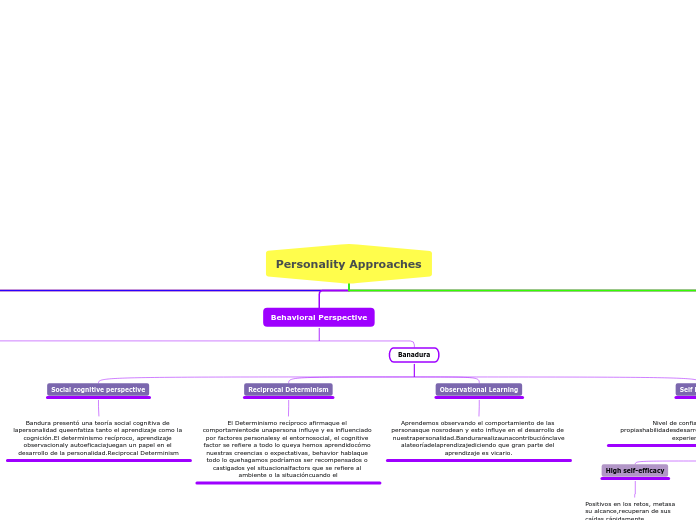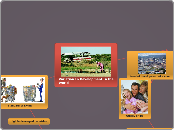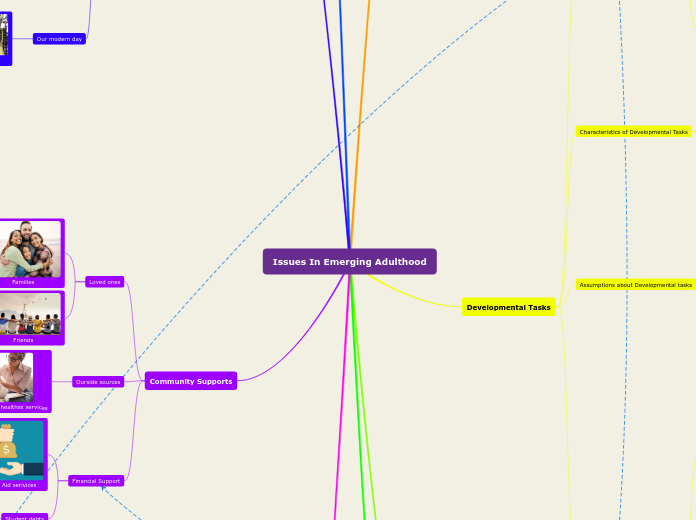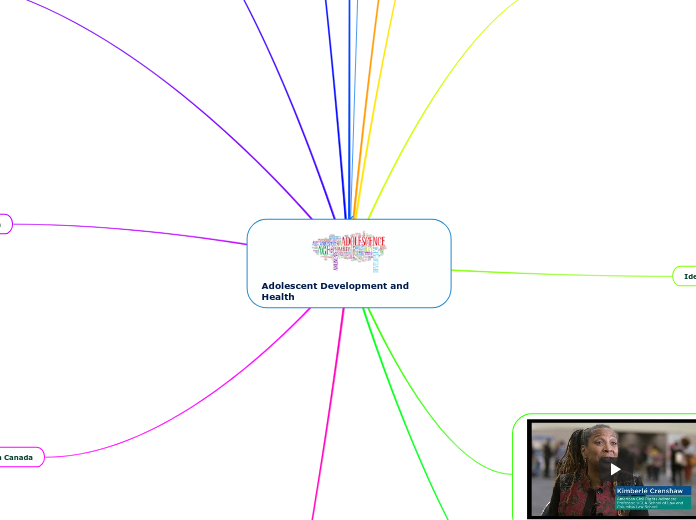Personality Approaches
Make a weekly plan, fill in each task and then check them off as the week advances.
Cultural Understanding of Personality
The 5 big factors help to determine a country's personality differences:
Asian culturesare more collectivist, and people in these cultures tend to be less extroverted. People in theCenter and South of American culturestend to score higher on openness to experience, whileEuropeansscore higher on neuroticism.
Selective migration: is the concept that people choose to move to places that are compatible with their personalities and needs.
Individualist cultures displayed more personally oriented traits, with collective cultures displayed more socially oriented personality traits.
There are three approaches that can be used to study the personality in a cultural context
The Combined Approach.
Which serves as a bridge between western and indigenous psychology as a way of understanding the universal and cultural variations of personality.
The Indigenous Approach
That arose as a reaction to the domain of Western approaches for the study of personality in non-western environments.
The Cultural-Comparative Approach
Seeks to prove western ideas about personality in other cultures to determine if they can be generalized and if they have cultural validity.
Personality is shaped by both genetic and environmental factors. The culture in which we live is one of the most important environmental factors that shapes our personality.
Traits Approach
The 5 Factor Model (OCEAN)
Neuroticism (Tendecy toward unstable emotions)
Anxious, unhappy, prone to negative emotions
Calm, even-tempered, secure
Agreeableness (Cooperative, trustworthy, good-natured)
Helpeful, trusting, empathetic
Critical, uncooperative, suspicious
Extrovertion (Sociability, assertivness, emotional expression)
Outgoing, warm, seeks adventure
Quiet, reserved, withdrawn
Conscientiousness (Competence, self-deiscipline, thoughtfulness, goal-driven)
Hardworking, dependable, organized
Impulsive, careless, disorganized
Oppenness (Imagination, feelings, actions, ideas)
High Score
Curious, wide range of interests, independent
Low Score
Practical, conventional, prefers routine
Biological Approaches
Friday
We all love Friday! And it's finally here. Look back at what you've managed to achieve this week and check what's in the pipeline for today.
Body type Temperament Studies
Are larger, with well defined muscles, narrow waist and strong bodies.
Adventurous, Assertive, Competitive, Fearless, Curious, Obnoxious, Aggressive
Endomorphs
Are larger, with bigger bone structures and extra fat on their bodies.
Relaxed, Comfortable, Humorous, Even tempered, Social, Tolerant, Aectionate
Ectomorphs
Are thin with very low mass of fat on their bodies.
Anxious, Self Conscious, Artistic, Thoughtful, Quiet, Private, Antisocial
Our demeanor may be a combination of physiological, genetic factors as well as a product of the environment and culture we are raised in.
Minnesota Study of Twins
Behavioral genetics study: 1979 to 1999 350 pairs of twins were separated and raised un a ware of their siblings.
RESULTS: IDENTICAL TWINS HAVE VERY SIMILAR PERSONALITY AND PHYSIOLOGICAL TRAITS WEATHER THEY WERE RAISED TOGETHER OR APART.
TEMPERAMENTS: Start developing early in our lives and there are three types, (easy,dicult and slow to warm up) to identify it when we’re babies.
Humanistic Approaches
Thursday
Happy Thursday! Hang in there, Friday will come before you know it. Think back to all the tasks scheduled for this week and see what else is left for today.
The assumption that people have free will,also with the idea that all people are good and they can work and learn to make themselves and the world better, they are motivated to actualize themselves. Humanistic approaches focus on the uniqueness of eachindividual.
Humanistic approaches offer a new set of values for approaching an understanding of human nature and the human condition, an expanded horizon of methods of inquiry in the study of human behavior and a broader range of more effective methods in the professional practiceof psychotherapy.
Rogers
Rogers identified five characteristics of the fullyfunctioning person:
5. Fulfilled life
A person is happy and satisfied with life, and always looking for new challenges and experiences.
4. Creativity
Creative thinking and risk-taking are features of a person’s life. A person does not play safe all the time. This involves the ability to adjust and change and seek new experiences.
3. Trust feelings
Feeling, instincts, and gut-reactions are paid attention to and trusted. People’s own decisions are the right ones, and we should trust ourselves to make the right choices.
2. Existential living
In touch with different experiences as they occur in life, avoiding prejudging and preconceptions. Being able to live and fully appreciate the present, not always looking back to the past or forward to the future (i.e., living for the moment)
1. Open to experience
Both positive and negative emotions accepted. Negative feelings are not denied, but worked through (rather than resorting to ego defense mechanisms).
Added that for a person to "grow", they need an environmen that provides them with genuineness
(openness and self-disclosure), acceptance (being seen with unconditional positive regard), and empathy (being listened to and understood).
Maslow
Investiga las 3 fuerzas de la psicología
Humanismo
Surgió como reacción al conductismo y al psicoanálisis, dos teorías con planteamientos opuestos en muchos sentidos pero que predominaban en ese momento además de que también surge por la segunda guerra mundial.
Conductismo
El conductismo, el análisis experimental del comportamiento y la ingeniería del comportamiento, en el campo de la terapia como de la modificación de conducta.
Psicoanálisis
El psicoanálisis es una teoría sobre los procesos psíquicos inconscientes, que presenta una concepción ampliada de la sexualidad, de sus relaciones con el acontecer psíquico y su reflejo en lo sociocultural.
Behavioral Perspective
Wednesday
Wednesdays are like Mondays in the middle of the week, they say. You're halfway through the week, see what plans you have set for today.
Banadura
Self Efficacy
Nivel de confianza en nuestras propiashabilidadesdesarrolladas a través de nuestra experiencia social.
Low self-efficacy
Evitan los retos, se enfocan enlo que puedesalir mal, pierden confianza cada vez que hacen algomal.
High self-efficacy
Positivos en los retos, metasa su alcance,recuperan de sus caídas rápidamente.
Observational Learning
Aprendemos observando el comportamiento de las personasque nosrodean y esto influye en el desarrollo de nuestrapersonalidad.Bandurarealizaunacontribuciónclavealateoríadelaprendizajediciendo que gran parte del aprendizaje es vicario.
Reciprocal Determinism
El Determinismo recíproco afirmaque el comportamientode unapersona influye y es influenciado por factores personalesy el entornosocial, el cognitive factor se refiere a todo lo queya hemos aprendidocómo nuestras creencias o expectativas, behavior hablaque todo lo quehagamos podríamos ser recompensados o castigados yel situacionalfactors que se refiere al ambiente o la situacióncuando el
Social cognitive perspective
Bandura presentó una teoría social cognitiva de lapersonalidad queenfatiza tanto el aprendizaje como la cognición.El determinismo recíproco, aprendizaje observacionaly autoeficaciajuegan un papel en el desarrollo de la personalidad.Reciprocal Determinism
Skinner
We learn to behave in particular ways. We increase the behaviors that lead to positive consequences, and we decrease the behaviors that lead to negative consequences.
Personality develops over our entire life, not only in the first few years. Our responses can change as we come across new situations; therefore,we can expect more variability over time in personality than Freud would anticipate.
The things we experience and our environment are the drivers of how we act.
Skinner proposed that we demonstrate consistent behavior patterns because we have developed certain response tendenciesc
Neo-Freudian
Tuesday
You got through Monday! Congratulations! Now let's see what tasks are in the pipeline for today.
Adler
El orden de nacimiento
Básicamente a lo que se refiere es que dependiendo de el orden en cuando nazcasinfluirá en tu personalidad.
Ejemplo: Si eres el hermano de en medio como no eres ni el mayor ni el menor, nunca eres el primero que se equivoca en la vida ni el último lo que te dará más posibilidades de equivocarte y por ende serás más libre y más independiente.
Las 3 tareas sociales fundamentales
La tarea amorosa (encontrar una pareja íntima para una relación a largo plazo) “procrear”
Tarea ocupacional (carrera)
Tarea social (amistad)
Conexiones sociales
Adler también creía en la importancia de las conexiones sociales, al ver que el desarrollo infantil surgía a través del desarrollo social en lugar de las etapas sexuales descritas por Freud. Adler señaló la interrelación de la humanidad y la necesidad de trabajar juntos para el mejoramiento de todos.
Complejo de inferioridad.
Ejemplo muy básico: El niño se siente inferior por el mero hecho de ser pequeño y sentirse desamparado.
Adler lo considera como universal en el hombre, osea que todos lo experimentamos en algún momento cuando éramos pequeños y nacimos donde fuimos vulnerables.
Se refiere a los sentimientos de una persona sobre que carece de valor y no está a la altura de los estándares de la sociedad o de otros
Erikson
Subtoproposed a psychosocial theory of development, suggesting that an individual’s personality develops throughout the lifespan (a departure from Freud’s view that personality is fixed in early life). The development of a healthy personality and a sense of competence depend on the successful completion of each task. ic
Las 8 etapas psicológicas
La etapa 8 se ubica de los 65 años en adelante
Integrity vs despair: After you have lived a full adult life and now you're entering your elderly years, you may be aware of your contributions and legacy, you are now experiencing that legacy, but if you didn't really filled the glass, you may feel desperate, depressive and feeling you have wasted your life.
La etapa 7 se ubica de los 30 a 64 años
Generativity vs stagnation: After you have established your personal life, now you will play a part in society and build your legacy, your role is to act all that you have learned throughout years of experience, if this doesn't happen you can keep with stagnation and feel like a loser.
La etapa 6 se ubica de los 19 a 29años
Intimacy vs isolation: Here after you have your role and personality developed, also after leaving your parents or old relationships behind, you now try to establish your long term relationships in your independent life, they can be friendships or romantic, if you don't find it you can feel extreme isolation, and it may lead to depression.
La etapa 5 se ubica de los 12 a 18 años
Identity vs confusion: In this stage you start to develop your roles and identity, you're now more independent and you define your personality, this search can also lead to confusion and you can feel alienated or lost.
La etapa 4 se ubica de los 7 a 11 años
Laboriosidad/ inferioridad: Se desarrolla confianza en sus propias habilidades y también la competencia con los demás y haciendo comparaciones con los mismos.
La etapa 3 se ubica en los 3 a 6 años
Esta se llama iniciativa/culpa y se llama así porque en estas edades toman la iniciativa de hacer actividades como dibujar pero también desarrollan culpa por sus acciones en especial cuando los padres le Incan entre lo que es correcto o no.
La etapa 2 es de 1 a 3 años
Se llama autonomía/vergüenza y duda, esta es la etapa en la que comienzan a hacer cosas por si mismo, cómo comer con sus manos, desarrolla su voluntad y la determinación pero también su impulsividad al querer conocer nuevas cosas o en su interacción con el entorno.
La etapa 1 es de 0 a 1 año
Se llama la etapa de confianza/ desconfianza porque aquí se desarrolla una confianza con los que los rodea como su madre y en sus necesidades básicas, conociéndolas. Es entre lo conocido y lo que desconoce.
Jung
Persona is a mask that we create from our conscious experiences and our collective unconscious. The purpose of it is a compromise between who we really are and what society expects us to be.
Jung believed that people can bet introvert and extrovert some characteristics are:
Extroverts
Jumps from topic to topic, acts first thinks later, thinks out loud, seeks attention, etc.
Introverts
Speaks slowly and softly, thinks before speaking, avoids attention, cautious, etc.
The collective unconscious is a universal version of the personal unconscious it holds mental patterns or memory traces. Archetypes are ancestral memories and they can be represented in different types of things.
Horney
Her theories focus on the role of unconscious anxiety
Horney’s three coping styles
Moving away from people
Description: Detachment and isolation
Example: They center on the isolation and everything that involvesbeing alone, they manage theiranxiety by keeping everything for themselves, theyavoid problems by having their ownprivacy
Moving against peoplec
Description: Aggression and manipulation
Example: Children tend to be more aggressive,by fighting or bullying other kids, thereason is because for them when they have issues orthey are unhappy at home or with theirparents, they have these actions, for them it’s thebest way to deal with it.
Moving toward people
Description: Affiliation and dependence
Example: Children become more dependent on their parents, theyreceive attention and what theywant and in that way they they have a feeling of relieffrom anxiety
Horney believed that a children’s development can be stuck by their experiences, isolation and loneliness.
Also believes that this copies are the way persons deal with problems, its a simple formulathat predicts how you are going to behave as an adultdepending on how you are as a child. This behaviours depend a lot on the environment, mostly from family, the atmosphere of a family intervines a lot on a person behaviour since baby, that’s why is important to know how to correct your child since he is a baby
Freud
Monday
A fresh start, a clean slate, and a lot of potential for great things to come. That is what Mondays really are!
Begin your week with a good plan in mind and follow the guidelines to organize the week ahead.
Psychodynamic Perspective
Freud´s Stages Of Psychosexual Development
Genital (12+) years
Latency (6-12) years
Erogenous Zone: None
Major Conflict: None
Aduly Fixation Examlpe: None
Phallic (3-6) years
Erogenous Zone: Genitals
Major Conflict: Oedipus/Electra complex
Aduly Fixation Examlpe: Vanity, overambition
Anal (1-3) years
Erogenous Zone: Anus
Major Conflict: Toilet training
Aduly Fixation Examlpe: Neatness, messiness
Oral (0-1) years
Erogenous Zone: Mouth
Major Conflict: Weaning off breast or bottle
Aduly Fixation Examlpe: Smoking, overeating
Defense Mechanisms
Freud believed that feelings of anxiety result from the ego’s inability to mediate the conflict between the id and superego. When this happens, Freud believed that the ego seeks to restore balance through various protective measures known as defense mechanisms.
Sublimation: Redirecting unacceptable desires through socially acceptable channels
Jerome´s desire for revange on the druk driver who killed his son is channeled into community support group for people who´ve lost loved ones to drunk driving.
Repression: Supressing painful memories and thoughts
LaShea cannot remember her grandfather´s fatal heart attack, although she was present.
Regression: Returning to coping strategies for less mature stages of development
After failing to pass his doctoral examinations, Giorgio spends days in bed cuddling his favorite childhood toy.
Reaction Formation: Reducing anxiety by adopting beliefs contary to your own beliefs
Nadia is angry with her coworker Beth for always arriving late to work after a night of partying, but she is nice and agreeableto Beth and affirms the partying as "cool".
Rationalization: Justifying behaviours by substituting acceptable reasons for less-acceptable real reasons
Kim failed history course because he did not study or attend class, but he told his roommates that he failed because the professor didn´t like him.
Projection: Attributing unacceptable desires to others
Chris often cheats on her boyfriend because she suspects he is already cheating on her.









